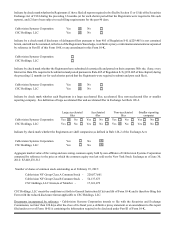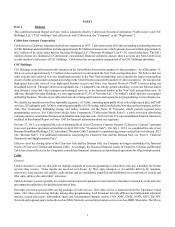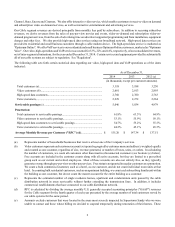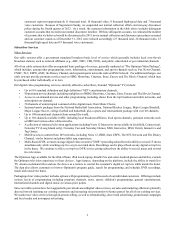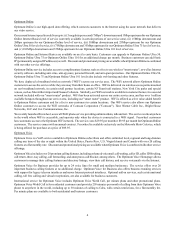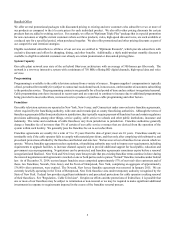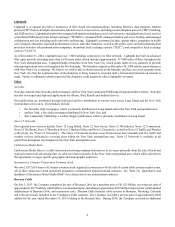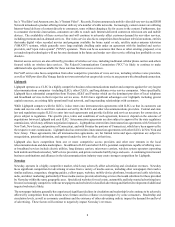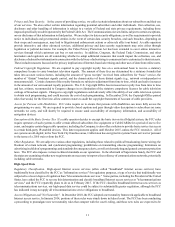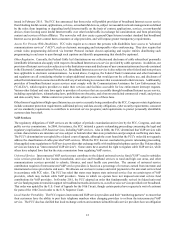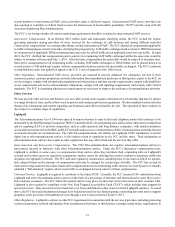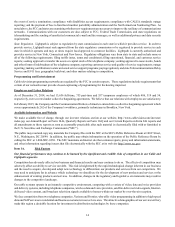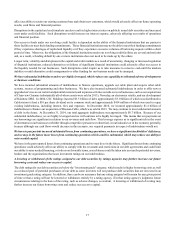Cablevision 2014 Annual Report Download - page 14
Download and view the complete annual report
Please find page 14 of the 2014 Cablevision annual report below. You can navigate through the pages in the report by either clicking on the pages listed below, or by using the keyword search tool below to find specific information within the annual report.
8
Inc.'s "YouTube" and Amazon.com, Inc.'s "Instant Video". Recently, Verizon announced a mobile video delivery service and DISH
Network introduced a product offering Internet delivery of a number of cable networks. Increasingly, content owners are utilizing
Internet-based delivery of content directly to consumers, some without charging a fee for access to the content. Furthermore, due
to consumer electronics innovations, consumers are able to watch such Internet-delivered content on television sets and mobile
devices. The availability of these services has and will continue to adversely affect customer demand for our video services,
including premium and on-demand services. Our video service also faces competition from broadcast television stations, entities
that make digital video recorded movies and programs available for home rental or sale, satellite master antenna television
("SMATV") systems, which generally serve large multiple dwelling units under an agreement with the landlord and service
providers, and "open video system" ("OVS") operators. There can be no assurance that these or other existing, proposed, or as
yet undeveloped technologies will not become dominant in the future and render our video service offering less profitable or even
obsolete.
Internet access services are also offered by providers of wireless services, including traditional cellular phone carriers and others
focused solely on wireless data services. The Federal Communications Commission ("FCC") is likely to continue to make
additional radio spectrum available for these wireless Internet access services.
Our VoIP service also faces competition from other competitive providers of voice services, including wireless voice providers,
as well as VoIP providers like Vonage that do not own networks but can provide service to any person with a broadband connection.
Lightpath
Lightpath operates as a CLEC in a highly competitive business telecommunications market and competes against the very largest
telecommunications companies - including ILECs, other CLECs, and long distance voice service companies. More specifically,
Lightpath faces substantial competition from Verizon, AT&T and Frontier which are the dominant providers of local telephone
and broadband services in their respective service areas. ILECs have significant advantages over Lightpath, including greater
capital resources, an existing fully operational local network, and long standing relationships with customers.
While Lightpath competes with the ILECs, it also enters into interconnection agreements with ILECs so that its customers can
make and receive calls to and from customers served by the ILECs and other telecommunications providers. Federal and state
law and regulations require ILECs to enter into such agreements and provide facilities and services necessary for connection, at
prices subject to regulation. The specific price, terms and conditions of each agreement, however, depend on the outcome of
negotiations between Lightpath and each ILEC. Interconnection agreements are also subject to approval by the state regulatory
commissions, which may arbitrate negotiation impasses. Lightpath has entered into interconnection agreements with Verizon for
New York, New Jersey, and portions of Connecticut, and with Frontier for portions of Connecticut, which have been approved by
the respective state commissions. Lightpath also has entered into interconnection agreements with other ILECs in New York and
New Jersey. These agreements, like all interconnection agreements, are for limited terms and upon expiration are subject to
renegotiation, potential arbitration, and approval under the laws in effect at that time.
Lightpath also faces competition from one or more competitive access providers and other new entrants in the local
telecommunications and data marketplace. In addition to ILECs and other CLECs, potential competitors capable of offering voice
or broadband services include electric utilities, long distance carriers, microwave carriers, wireless system operators (operating
both mobile and fixed networks), VoIP service providers, and private networks built by large end users. A continuing trend toward
business combinations and alliances in the telecommunications industry may create stronger competition for Lightpath.
Newsday
Newsday operates in a highly competitive market, which may adversely affect advertising and circulation revenues. Newsday
faces significant competition for advertising revenue from a variety of media sources, including other newspapers that reach a
similar audience, magazines, shopping guides, yellow pages, websites, mobile-device platforms, broadcast and cable television,
radio, and direct marketing; particularly if those media sources provide advertising services that could substitute for those provided
by Newsday within the same geographic area. Specialized websites for real estate, automobile and help wanted advertising have
become increasingly competitive with our newspapers and websites for classified advertising and further development of additional
targeted websites is likely.
The newspaper industry generally has experienced significant declines in circulation and readership levels continue to be adversely
affected by competition from new media news formats and less reliance on newspapers by some consumers. Readership and
circulation levels, as well as economic conditions and the existence of other advertising outlets, impact the demand for and level
of advertising. These factors will continue to negatively impact Newsday’s revenues.


